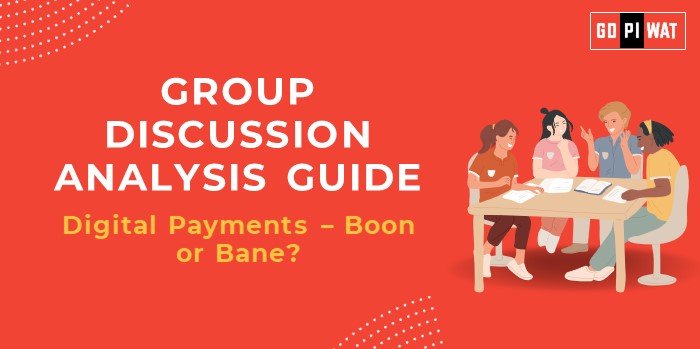📋 Group Discussion Analysis Guide: Digital Payments – Boon or Bane?
🌐 Introduction to Digital Payments
India’s digital payments landscape is evolving rapidly, becoming one of the most transformative sectors in the economy. Initiatives like the Unified Payments Interface (UPI) have redefined how transactions occur across all income groups, aiming to foster financial inclusion and economic growth. However, the benefits are accompanied by challenges, such as cybersecurity threats, a significant rural-urban divide, and resistance from smaller merchants.
📊 Quick Facts and Key Statistics
- 📈 UPI Transactions: Surpassed 22.7 billion in 2023, valued at around $768 billion; UPI is expected to handle 15-20 billion monthly transactions in 2024.
- 📊 Market Share and Transaction Value: UPI holds a 68% share in retail digital payments in India, valued at $3.6 trillion in FY24.
- 📈 Retail Digital Payments Growth: Increased from $300 billion in FY18 to $3.6 trillion in FY24, projected to double to $7 trillion by FY30.
- 🏡 Rural and Small-Town Expansion: Driven by adoption in smaller towns, this next growth phase shows smaller cities adopting digital solutions at rates similar to metro areas.
- ⚠️ Security Concerns: Widespread concerns about fraud and security, with apprehensions about double debiting and phishing scams impacting adoption in smaller towns.
🔍 Stakeholders and Their Roles
- 🏛️ Government and Regulatory Bodies: Provide frameworks and policies to support digital payment infrastructure, such as UPI and Aadhaar-enabled payment systems.
- 💼 Private Sector & Fintechs: Companies like PhonePe, Paytm, and Amazon Pay drive technological innovation and expansion into new markets.
- 👥 Consumers and Merchants: Consumer adoption is critical, while merchants, especially in smaller towns, face challenges like liquidity needs and infrastructure gaps.
- 🌍 International Partners: Collaborate in expanding payment technologies but introduce concerns over data privacy and sovereignty.
🏆 Achievements and Challenges
✨ Achievements:
- 💡 Financial Inclusion: UPI and other payment platforms enable millions to participate in the formal economy.
- 🚀 Rapid Adoption and Transaction Growth: UPI and mobile wallets streamline payments and have become preferred methods for 90% of online transactions.
- 💸 Reduction in Cash Dependency: Digital payments support the transition toward a less-cash economy, with strong growth in smaller cities and towns.
⚠️ Challenges:
- 🔒 Cybersecurity: Rising digital fraud cases deter potential users, especially in smaller cities.
- 📶 Digital Divide: Low digital literacy and limited infrastructure hinder widespread adoption in rural areas.
- 💵 Merchants’ Resistance: Many small-town merchants prefer cash, citing cash flow issues and concerns over internet reliability.
📄 Structured Arguments for Discussion
Supporting Stance: “Digital payments drive financial inclusion and economic growth, empowering millions through accessible transaction solutions.”
Opposing Stance: “Reliance on digital payments introduces security vulnerabilities and creates barriers for those with limited internet access.”
Balanced Perspective: “Digital payments offer significant benefits but need stronger security measures and rural infrastructure for inclusive growth.”
💬 Effective Discussion Approaches
Opening Approach: “India’s digital payments have reached $3.6 trillion in value, largely driven by UPI, yet security issues and rural access remain key concerns.”
Counter-Argument Handling: Acknowledge cybersecurity threats, then emphasize initiatives like RBI’s cybersecurity guidelines and the success of PMGDISHA in rural digital literacy.
📊 Strengths, Weaknesses, Opportunities, and Threats (SWOT)
- 💪 Strengths: Broad reach of UPI; rapid adoption among young consumers; government support.
- ⚠️ Weaknesses: Cybersecurity vulnerabilities; dependence on internet access; merchant hesitancy in smaller towns.
- 🚀 Opportunities: New payment technologies like digital rupee, AI-driven fraud prevention.
- ⚡ Threats: Data breaches, potential regulatory challenges, and user resistance in less connected areas.
🎓 Connecting with B-School Applications
Real-World Applications: Research projects in digital banking, cybersecurity in payments, and fintech innovations.
Sample Interview Questions:
- ❓ “What role do digital payments play in expanding financial inclusion?”
- ❓ “How can India’s digital payment systems address cybersecurity concerns effectively?”
Insights for B-School Students:
- 💡 Recognize digital payments as key drivers of fintech growth.
- 🔍 Develop knowledge on balancing tech-driven growth with user security.
- 🌍 Explore applications in rural development and financial inclusion.


